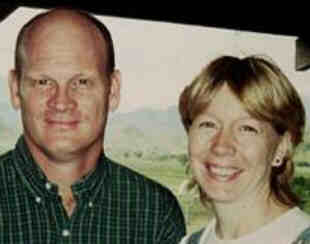2002 The stock of Tyco International (TYC) falls to a six year low $9.45 intraday from its previous close of $14.66 and closes at $10.10. — 04 June details on earlier drop and causes.
2002 Leges Danorum de immigratione: Parlamentum Danorum leges pertulit, quibus immigratio coerceretur. Numerus peregrinorum in Daniam venientium temperabitur et condiciones, quibus asylum petentibus venia commorandi conceditur, fient difficiliores. Licentia perpetuo in Dania manendi peregrino non dabitur, antequam septem annos ibi habitaverit. Antea haec licentia post triennium data est. Neque peregrinus plenam cautionem socialem nisi septennio in Dania transacto habere poterit. Ius familiam coniungendi tantum homines minime viginti quattuor annorum habebunt. Illud ius antea nullo modo circumscribebatur. Propositum est impedire, ne peregrini fictis matrimoniis concives suos nomine familiarium in Daniam inducant.
2001 Parliamentary elections in the UK. Labour wins, so Tony Blair continues as Prime Minister.
2001 NetZero and Juno Online Services, the two biggest providers of free Internet access in the US, announce that they will merge towards the end of 2001, as United Online, with. 7 million subscribers, second behind America Online, which has 29 million subscribers, and ahead of Microsoft's MSN with its 5 million subscribers.
 2001
Former Argentine President arrested.
^top^ 2001
Former Argentine President arrested.
^top^Carlos Menem is put under house arrest as part of an investigation into illegal arms sales. Menem is ordered held by federal judge Jorge Urso probing accusations that the former president headed an "illicit organization" that funneled arms to Croatia and Ecuador in 1991 and 1995, despite international arms embargoes on both nations. [photo: Menem, accompanied by his Chilean wife Cecilia Bolocco leaves court for house arrest >] Investigators have alleged that Menem and his aides organized the sale of 6500 tons of weapons. The weapons were officially destined for Panama and Venezuela but ended up in Croatia and Ecuador respectively. During that period, Argentina was bound by international agreements that enforced arms embargoes on Croatia and Ecuador. Ecuador and Peru waged a brief border war in the 1990s, and the embargo against Croatia stemmed from fighting in the former Yugoslavia. Menem, 70, will be under house arrest during any prosecution. If charged and convicted, he could face a sentence of three to 10 years house arrest. Under Argentine law, people 70 years or older cannot be put in prison. The court had no immediate confirmation of the detention, but it was also widely reported by local media. Menem has insisted the sales were done "absolutely legally" and that he was the victim of "political persecution." "I am very calm. Can't you see that?" Menem said earlier Thursday as hundreds of supporters crowded around him outside the federal courthouse, where he arrived to testify before Federal Judge Jorge Urso. "I trust in justice," said Menem, who wore a stylish brown suit and gold tie and was flanked by his new bride, Urso's probe has led to the recent detention of three other former Menem advisers. On 6 June 2001 a retired former army chief who served under Menem's government was detained. General Martin Balza, the highest-ranking army officer during most of Menem's presidency, was accused of being an organizer of a ring that conspired to secretly sell arms to Croatia and Ecuador. In May 2001 Antonio Erman Gonzalez, a former defense minister under Menem, was detained in connection with the case. Former presidential aide Emir Yoma, the brother of Menem's ex-wife Zulema Yoma, was detained on 7 April 2001 on charges of complicity in the alleged arms ring. Menem, who served two consecutive terms that ended in December 1999, closed out his presidency amid accusations of corruption in his administration. The former president, who married the 36-year-old former Miss Universe Cecilia Bolocco of Chile. on 26 May 2001, is best remembered for repairing a broken economy he inherited upon taking office in 1989. During his presidency, Menem managed to transform the economy with free-market reforms that included toppling trade barriers and selling off hundreds of state companies while stabilizing the currency. He also reopened ties with Britain after the two countries had gone to war over the Falkland Islands and reinforced democracy by defusing the destabilizing grievances of the military. He tamed inflation that had been as high as 200% a month and brought on years of economic growth. His government calmed the volatile currency by pegging it to the dollar. Since leaving office, Menem has served as leader of his Peronist Party and talked openly about his desire to run for the presidency again in 2003. Carlos Saúl Menem Akil was born on 02 July 1930 in Anillaco, Argentina, and educated at Córdoba University. The son of Syrian immigrants, he was raised as a Sunni Muslim. He converted to Roman Catholicism in his youth and became politically active while still a student. In 1955 he founded the Juventud Peronista, a Peronist youth group. He was briefly jailed the next year for his role in an attempt to restore the ousted dictator [next link is broken] Juan Perón to power. In 1956 Menem became legal adviser to the Confederación General del Trabajo (General Confederation of Labor), a trade union group and a major Perón supporter. Menem ran for the seat of deputy of his native La Rioja Province in 1962, but a military coup aborted the election. He was elected provincial president of the Peronist Party in 1963. In 1973, after Perón's return to power, Menem was elected governor of the La Rioja Province. On 24 March 1976 a military coup led by general Jorge Rafael Videla ousted Argentine [next link is broken] Isabel de Perón, the dictator's widow and successor. Menem was jailed and not not released until 1981. He was reelected governor of La Rioja Province in 1983 and 1987. In 1989 he was elected president of Argentina in the first transfer of power in Argentina from one constitutionally elected party to another since 1928. A flamboyant figure, Menem described his political philosophy, Peronism, as nationalist, populist, humanist, socialist, and Christian. He worked to reform the structure of the state, privatize business, achieve a free market, and restore connections with the United Kingdom. In 1992 Menem ordered that all secret files pertaining to Nazis in Argentina after World War II (1939-1945) be opened to the public. His success in bringing inflation and the economy of Argentina under control helped him win a second term as president in 1995. Menem was constitutionally barred from running for a third consecutive term in 1999, and was on 10 December 1999 succeeded by Fernando de la Ruá Bruno (born on 15 September 1937), who had won the 24 October 1999 election.. Carlos Saúl Menem is a politician and lawyer who in 1989 became the first Peronist to be elected president of Argentina since Juan Perón in 1973. He led the country for 10 years (1989–99). Menem, the son of Syrian immigrants, was raised a Muslim. His political aspirations, however, led him to convert to Roman Catholicism, the official religion of Argentina. He joined the Peronist (Partido Justicialista) movement in 1956 and was briefly imprisoned that year after participating in a revolt aimed at restoring Juan Perón (who had been ousted from power) to the presidency. After obtaining a law degree from the National University of Córdoba in 1958, Menem began a career as a trade union lawyer in the northwestern city of La Rioja. He was elected governor of La Rioja province in 1973 but was expelled from office in 1976 by the military junta that had overthrown the government of Isabel Perón. After regaining the governorship in 1983, Menem expanded the size of government, gave favourable tax breaks to businesses, and pursued other policies typical of the Peronist movement. His support base among Peronists grew, and in May 1989, amid the worst economic crisis in the country's history, he was elected president of Argentina. High inflation forced Menem to abandon his party orthodoxy in favour of a fiscally conservative, market-oriented economic policy. With the aid of many non-Peronist cabinet members, he succeeded in stabilizing the economy. Menem cultivated a flamboyant image and enjoyed great national popularity despite sharp criticism for pardoning convicted human-rights violators connected with the period of military rule (1976–83). Reelected president in 1995, Menem sought to improve relations with Great Britain. His 1998 trip marked the first time an Argentine leader had visited Britain since the Falkland Islands War (1982). Menem and British Prime Minister Tony Blair agreed to promote bilateral trade and investment. Barred constitutionally from running for a third consecutive term, Menem was succeeded by Fernando de la Rúa of the Alliance party in December 1999. Carlos Saúl Menem Akil est né à Anillaco, petit village de la province de La Rioja, au nord-ouest de l'Argentine, d’une famille musulmane d’immigrants syriens (les Muni’im), chassée de chez elle par l’oppression turque. Carlos Menem will grow up to be a politician and lawyer, converting to Catholicism, and, in 1989, the first Peronist to be elected president of Argentina since Juan Perón in 1973. He was reelected in 1995. He was in office from 890708 to 991210. Arborant cheveux longs et patillas, ces larges favoris qui lui mangent le visage, il obtient à vingt et un ans son diplôme d’avocat. He joined the Peronist (Partido Justicialista) movement in 1956 and was briefly imprisoned that year after participating in a revolt aimed at restoring Juan Perón (who had been ousted from power) to the presidency. Menem est élu pour la première fois, en 1973, gouverneur de La Rioja. Il subit, à partir de 1976, les foudres des militaires et passe cinq ans sans procès dans les geôles de la dictature. Renouant avec la liberté et un style de vie tapageur -- sa participation à des courses automobiles et ses conquêtes féminines défraient plusieurs fois la chronique -- Carlos Menem est réélu gouverneur de sa province en 1983, puis en 1987. Sous les apparences d’un séducteur frivole, le dirigeant péroniste sait parler à ses administrés et se poser en défenseur de l’"autre Argentine" face à l’arrogance des porteños, les habitants de la capitale. Durant la campagne électorale pour la présidence, il ne s’est pas vraiment attaché à dissiper les équivoques. Sillonnant le pays au volant de sa "Menem-mobile", il répétait à l’envi son slogan ("Suivez-moi") -- sans préciser où -- et appelait à une mystérieuse "révolution productive". Beaucoup redoutaient l’avènement d’un "caudillo" démagogue, masquant le flou de son programme de propos populistes. Menem a fait montre d’habileté politique dans le traitement des dossiers, de constance dans ses choix, et il a su s’entourer de gestionnaires compétents. Mais dans les dernières années de sa présidence, ses différents avec la justice (divorce) et le blanchiment de narco-dollars ternirent considérablement son image. |
 Deaths
Deaths
